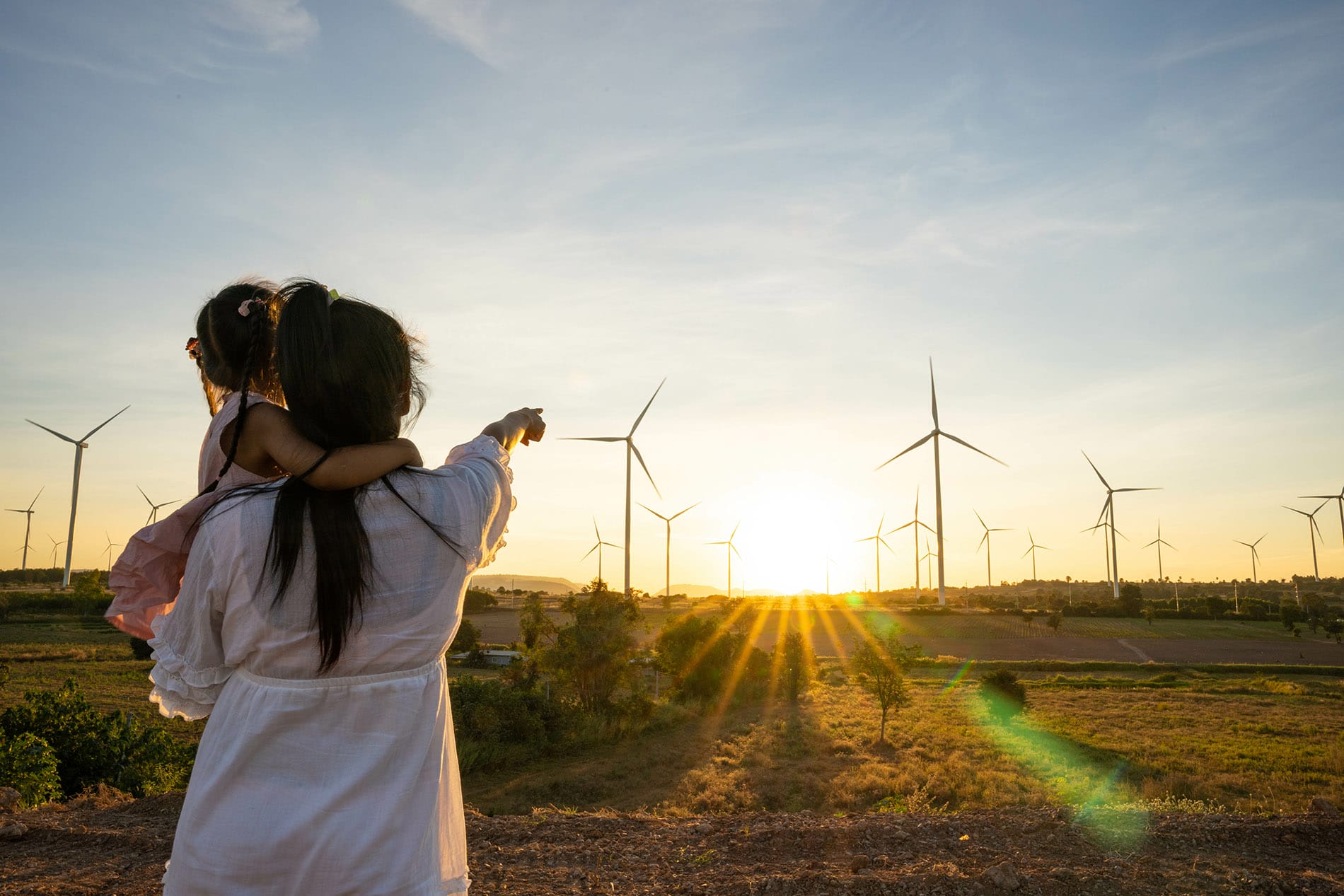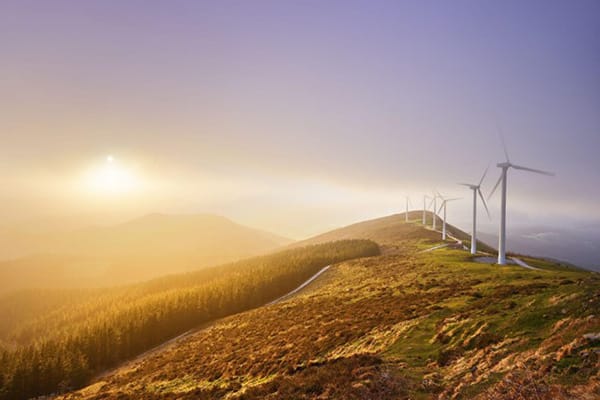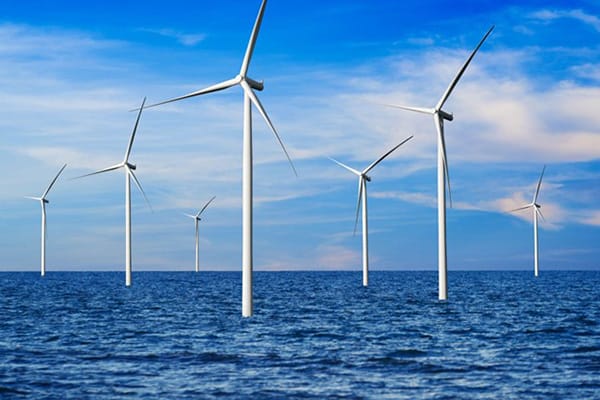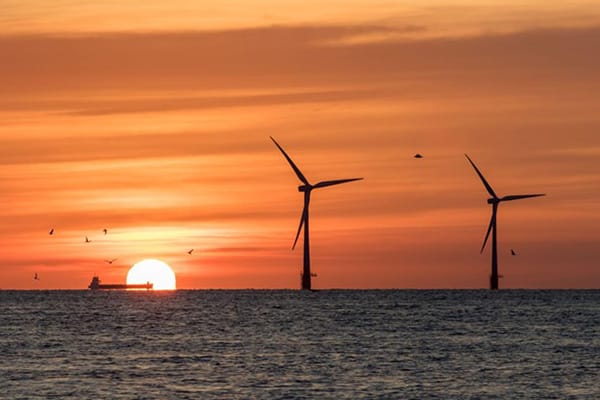Of the many ways we can combat climate change, one of the most promising and consequential is to limit emissions of greenhouse gases like carbon dioxide. It’s no surprise, then, that quite a lot of effort is spent devising new ways to effect an energy transition away from fossil fuels, which emit these gases, and toward more sources of energy that do not emit these gases.
A promising source of the clean energy we need for this transition comes from wind power plants and wind farms. There is, in fact, an entire wind industry being built to capture wind energy and bring it to market.
Let’s learn a little bit more about this fascinating industry and how it can contribute to the mix of technologies we use for electricity generation.
Understanding the Mechanics of Wind Energy
Wind energy is one of a family of renewable energy resources that converts wind into a usable form of electricity. Unlike fossil fuels like oil, coal, and natural gas, renewable energy sources like wind (and solar) are easily replenished and won’t run out. It’s worth stepping back to look more closely at wind to better understand how we can make better use of the plentiful wind resources that are all around us.
The air is predominantly made up of molecules of nitrogen, oxygen, and water vapor. These molecules constantly bounce around, hitting each other and striking any objects that happen to be nearby. We use the term “air pressure” to refer to just how energetically the air molecules are moving.
High-energy regions are denoted as high pressure, low-energy regions are denoted as low pressure, and air molecules will tend to move from relatively higher-pressure regions to lower-pressure regions.
Whether it’s a gale-force typhoon or a gentle breeze on a summer’s day, what we refer to as wind is really just this movement of air molecules down the air pressure gradient.
Reaping the Whirlwind
With this context well-established, we can turn now to the question of how we can use this wind power capacity to generate the electricity we need. Since this is usually accomplished with wind turbines, the question really boils down to discussing how wind turbines work.
Wind turbines are machines that use turbine blades to convert the kinetic energy of wind into electricity. Whereas a fan in your room draws power from a socket or battery and uses that to turn a blade, with a wind turbine the opposite process is occurring:
- Wind moves over the blades, causing them to turn.
- This motion spins a shaft inside the turbine that is hooked up to a generator.
- This generator uses the shaft’s motion to create electricity.
Big, white wind turbines are visible in many parts of the United States — one of the largest wind farms in the world is located in Abilene, Texas on 100,000 acres of land used to grow cotton – and this tends to be the image people have of wind turbines. These structures are referred to as utility-scale wind turbines, which are capable of generating 100 kilowatts or more of power. They are usually installed as part of wind farms, which contain multiple wind turbines.
It’s worth pointing out, however, that it’s also possible to buy smaller, standalone wind turbines for powering a residence or small office.
Using wind to make electricity is only step one. The next step is to send the power to an onsite transformer that boosts the voltage to match the voltage standard used by the broader U.S. electrical grid. From this point, it’s usually transferred to the national grid transmission network before being transmitted to homes and businesses.
This whole process — converting the motion of the wind into electricity, pushing that to the grid, and distributing it to the places where it is needed — is what is meant by “wind energy.”
What Is the Future of Wind Energy?
So far we’ve limited our discussion to the basics of wind energy, but there are a variety of future wind energy projects that are cause for excitement.
- Airborn Wind Turbines: We feel the wind on the surface of the Earth, of course, but it’s not the only place wind can be found. What if there were a way to untether wind turbines from the ground so as to take advantage of the greater kinetic energy of wind at higher altitudes? From gigantic kite designs to windsails, numerous wind energy projects are currently under development to do exactly this. Because they could be attached to docks or other structures, airborne wind systems can be used in many places where traditional turbines wouldn’t work.
- Wind Harvesting: In Singapore’s Nanyang Technological University, a team of scientists is at work on a low-cost wind harvester that is even able to generate electricity from a gentle breeze. The device utilizes the triboelectric effect, in which different materials are connected in layers that create electricity when vibrations from the wind cause them to separate from each other. At 6 inches by 8 inches it’s very small, but it nevertheless creates enough power for a small generator, meaning it could find use as a distributed energy resource.
- Windstalks: A common criticism of wind turbines is that their turbines create noise pollution and are a potential hazard for birds. What if it were possible to dispense with the turbine blades altogether? Atelier DNA, a New York-based design firm, is working on just such a concept. Their “windstalk” design is made up of layers of ceramic and electrodes that create electricity when they’re put under pressure. The structure will sway back and forth as the wind blows over it, pressurizing these layers and harvesting the resulting power, with no need for any turbines. Windstalks would be able to be installed much more densely than traditional turbines, which need a fair bit of space for their turbine blades to spin.
Though each of these projects is still in the initial stages of development, together they represent substantial advances over the current wind power technology. It’s too early to tell which project will succeed, or if any of them will, but it’s nevertheless exciting to see so much inventiveness being poured into a promising source of energy.
What Is Offshore Wind Energy?
A growing part of the wind industry is offshore wind power. As opposed to onshore wind, which is land-based, offshore wind energy sources refer to offshore wind turbines or offshore wind farms that are installed in the water, generally off of a nearby coast.
Enter your ZIP Code and compare electricity rates
There are a number of offshore wind projects in states like New York and California, and there is a burgeoning interest in building more such facilities. The Biden administration has announced its intention to reach at least 30 gigawatts (GWs) of total offshore wind power capacity by 2030, and the “Wind Vision Report” put out by the Department of Energy forecasts as much as 86 GWs by mid-century.
What Are the Benefits of Wind Energy?
The main benefit of wind energy is that it’s a source of renewable energy that can be used to feed an increasingly energy-hungry world. Whereas the total U.S. electricity generation accounted for by wind was negligible in 1990, it had risen to nearly 10% as of 2021. Put another way, wind energy created on the order of 6 billion kWhs in 2000, a figure which had climbed to almost 380 billion kWh in 2021.
Though 10% isn’t a huge figure, it’s also not a trivial one, and it indicates that wind power could be an important part of the electricity mix of the future.
Wind energy is also a way of boosting energy efficiency. In the right circumstances — if wind coverage is good enough and if the terrain is favorable for building turbines — wind could be one of the most cost-effective ways of producing power.
Moreover, wind produces effectively no waste, including no hint of greenhouse gases. Furthermore, the grass around the base of a wind turbine can still be used to graze animals or grow crops.
What Are the Challenges With Wind Energy?
While it offers many benefits, wind energy is not without its challenges and drawbacks. While wind energy was responsible for nearly 10% of total U.S. energy production in 2021, its generation capacity remains insufficient to single-handedly replace all-important fossil fuels like oil and natural gas.
Achieving a transition to a fully clean energy economy will therefore require wind power to be supplemented with other forms of renewable energy, such as hydropower and solar energy.
Wind power has been criticized due to potential noise pollution and bird deaths, but there’s also the fact that current wind plant designs simply require a lot of space. This makes them poorly suited to areas of high population density, low wind speed, or certain kinds of rocky terrain.
Despite these challenges, wind energy remains a promising form of renewable energy and will likely grow its role in our future.
Learn More About Our Wind-Powered Future
With climate change becoming a more pressing issue, some of the best minds in the world are busy looking for alternatives. We hear often of new breakthroughs in renewable energy technologies, which hold the promise of transitioning us to a clean energy economy while reducing greenhouse gas emissions and other forms of pollution.
There’s still a lot of research and development that needs to be done, but wind power is an exciting form of energy technology that’s being actively developed and already accounting for a sizable fraction of power generation in countries like the United States. Read on to learn more about different types of renewable energy and how it can improve both your life and the life of our planet.
Brought to you by energysavings.com
All images licensed from Adobe Stock.
Featured image:




